Zoom
Trash

Tier two vocabulary for primary teachers – the 3-4-5 list – Primary Colour. Vocabulary is an essential component of reading comprehension and learning.
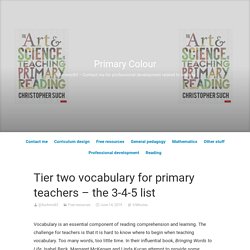
The challenge for teachers is that it is hard to know where to begin when teaching vocabulary. Too many words, too little time. Building Word Confidence: Everyone read, say, understand, use, practise. A very common phenomenon in many lessons is that students encounter new words.
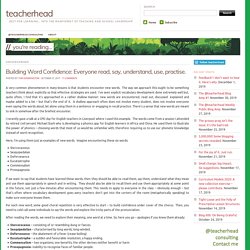
The way we approach this ought to be something teachers think about explicitly so that effective strategies are used. I’ve seen explicit vocabulary development done extremely well but, quite often, I find that it’s approached in a rather shallow manner: new words are encountered, read out, discussed explained and maybe added to a list – but that’s the end of it. A shallow approach often does not involve every student, does not involve everyone even saying the words aloud, let alone using them in a sentence or engaging in recall practice. Planning by verbivore city words2. Deepening knowledge through vocabulary learning. Shireland Collegiate Academy. Vocabulary Knowledge and the 'Frayer Model'
The ‘Frayer model‘ is a long-standing graphic organiser that has been deployed in classrooms with success for decades (it was first conceived Dorothy Frayer and her colleagues at the University of Wisconsin).
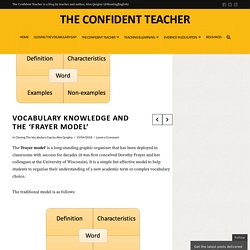
Vocabulary Development Reading List. For a long time now I have been reading about vocabulary development.
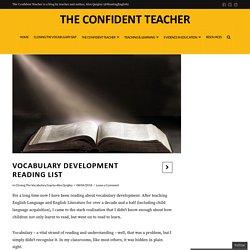
After teaching English Language and English Literature for over a decade and a half (including child language acquisition), I came to the stark realisation that I didn’t know enough about how children not only learnt to read, but went on to read to learn. Vocabulary – a vital strand of reading and understanding – well, that was a problem, but I simply didn’t recognise it. In my classrooms, like most others, it was hidden in plain sight. Over the last two years, since the new curriculum has crashed headlong into our schools, I have seen in classrooms the issues posed by increased reading comprehension demands, at primary and secondary school. I have been reading and researching, in making my book, ‘Closing the Vocabulary Gap‘, and I thought it would be useful to share that reading and offer really valuable links: Books: ‘The Reading Mind’, by Dan Willingham.
Building Word Confidence: Everyone read, say, understand, use, practise. 2d shapes. Triangles. ‘BOOK SCRUTINY’ – A peek inside the Power of Words. As promised in an earlier blog, here’s a collection of photos from the Power of Words books the children use to record their vocabulary learning during our daily ten-minute sessions.
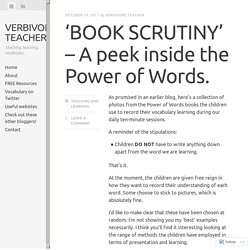
A reminder of the stipulations: Children DO NOT have to write anything down apart from the word we are learning. That’s it. At the moment, the children are given free reign in how they want to record their understanding of each word. Some choose to stick to pictures, which is absolutely fine. I’d like to make clear that these have been chosen at random. If you have any questions, don’t be afraid to chat. Ooh, if you have any feedback about the learning itself, do let me know and I can pass on to the kids! ‘BOOK SCRUTINY’ – A peek inside the Power of Words. Vocabulary: how to plan it.
Teaching words within a context is crucial if you want that word to embed in your children’s memories.
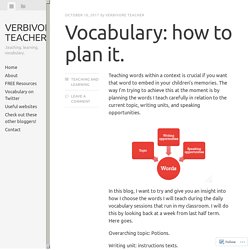
The way I’m trying to achieve this at the moment is by planning the words I teach carefully in relation to the current topic, writing units, and speaking opportunities. In this blog, I want to try and give you an insight into how I choose the words I will teach during the daily vocabulary sessions that run in my classroom. I will do this by looking back at a week from last half term. Here goes. Overarching topic: Potions. Writing unit: instructions texts. Words taught: simmering, potent, precise, concoct, consume. Systematic Vocabulary Instruction – John Kenny Blog. If you’re a new teacher like me, your knowledge of evidence-based practice is probably frustratingly limited.
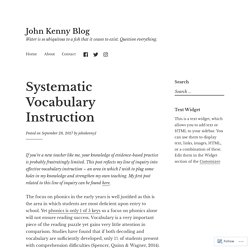
This post reflects my line of inquiry into effective vocabulary instruction – an area in which I wish to plug some holes in my knowledge and strengthen my own teaching. My first post related to this line of inquiry can be found here. The focus on phonics in the early years is well justified as this is the area in which students are most deficient upon entry to school.
Yet phonics is only 1 of 5 keys so a focus on phonics alone will not ensure reading success. Vocabulary is a very important piece of the reading puzzle yet gains very little attention in comparison. Part 1: ROOT PLANNER – Leading Language. This is the first of a two-part post.
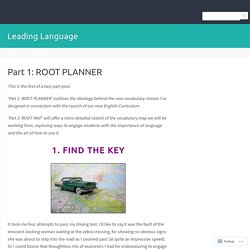
‘Part 1: ROOT PLANNER’ outlines the ideology behind the new vocabulary stream I’ve designed in connection with the launch of our new English Curriculum. ‘Part 2: ROOT MAP’ will offer a more detailed sketch of the vocabulary map we will be working from, exploring ways to engage students with the importance of language and the art of how to use it. It took me four attempts to pass my driving test. I’d like to say it was the fault of the innocent-looking woman waiting at the zebra crossing, for showing no obvious signs she was about to step into the road as I zoomed past (at quite an impressive speed). Wurdz. – primarytimerydotcom. ‘The old bear roared in frustration and waved at the empty air with his huge paws, then reared up on his hind legs .’
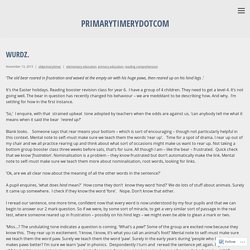
It’s the Easter holidays. Reading booster revision class for year 6. I have a group of 4 children. They need to get a level 4. It’s not going well. ‘So,’ I enquire, with that strained upbeat tone adopted by teachers when the odds are against us, ‘can anybody tell me what it means when it said the bear ‘reared up?’ Blank looks. ‘Ok, are we all clear now about the meaning of all the other words in the sentence?’ A pupil enquires, ‘what does hind mean?’ I reread our sentence, one more time, confident now that every word is now understood by my four pupils and that we can begin to answer our 2 mark question. The dawn of vocab mania. – verbivore teacher. To all those managing to share a blog a week as part of the #WeeklyBlogChallenge, I salute you.
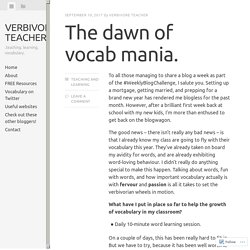
Setting up a mortgage, getting married, and prepping for a brand new year has rendered me blogless for the past month. Word workshop star simmering. Word workshop star precise. Vocabulary – 8 Ways to Raise Attainment! Last years SATs results prompted some soul searching on my own behalf, as to why our year 6 pupils struggled so much. Not only to attain within the SATs exams, but to even ACCESS them! So many words (simple and complex) acted as barriers to the children even understanding what the question wanted them to do. Subsequently, vocabulary became one of my key priorities for my current year 6 pupils. Assessing Vocabulary (Part 1) For this area of vocabulary development, I will be drawing upon the books that I’ve read (namely Bringing Words to Life and Word Aware), as well as the conversations I’ve had with other propagates of direct vocabulary instruction such as @29orry (more about her work further down).
My initial thoughts, and they still remain, is that new vocabulary should be assessed in some way. Primary English Education. Building Children’s Vocabularies What do you do when the children just don’t have the words? When you are faced with the same old words day after day? "Words unlock the doors to a world of understanding." KS1 and KS2 FREE WOD PACKS – Vocabulary Ninja. Grasshoppers! Welcome again to the Vocabulary Dojo!
Once again the Vocabulary Ninja has provided two amazing free resources for KS1 and KS2. Each document contains around 70 pages of Word of the Day resources. For Free! I have separated the previous WOD pack into two distinct WOD documents for use with your learners! All I ask is that you like, share, retweet and comment on the post to promote the Ninja to other educators, parents and ninjas! These resources have been mad available in memory of my cat, whom we sadly lost yesterday, Peaches. Vocabulary y7. Teaching Vocabulary. If this blog had themes, I’m sure one fairly major one would be ‘Changing my Mind.’ And lest readers consider me a fully paid up zealot of the ‘Knowledge Devotees,’ let me tell you that I have only recently changed my mind about teaching vocabulary.
Teaching content-rich lessons. 29% to 92%, a reading journey! – Just Teach It. Verbivore teacher. 'A generation of boys is being failed': Study finds gender divide in language skills when children start school. Boys are almost twice as likely as girls to be falling behind in their language skills by the time they start school, putting their chances of being successful in life at risk, according to a report from the charity Save the Children. Spending more time teaching vocab doesn't always work, study finds. The new study, conducted by Ann Arthur and Dawn Davis, from the University of Nebraska-Lincoln, in the US, found that there was no link between how much time pupils spent learning vocabulary and how much new vocabulary they learn.
How to...plan for and teach tricky vocabulary. Let’s start with a little activity. Vocabulary learning. Primary Ideas: 4 Pics 1 Word in Your Classroom. On Saturday, I was sat near a child on a train who was playing 4 Pics 1 Word on his father's phone. Vocabulary Strategies - Learning Tasks. Choosing Words to Teach. The teacher's edition for a fourth-grade anthology suggests teaching the following words before inviting students to read an excerpt from Charlotte's Web (White, 1952): comfort, cunning, endure, friendless, frolic, lonely, soaked, and stealthily.